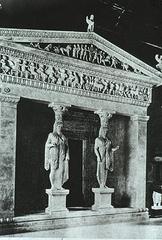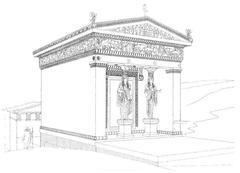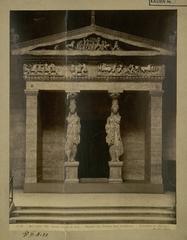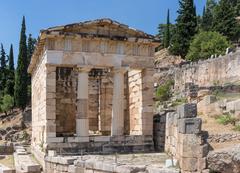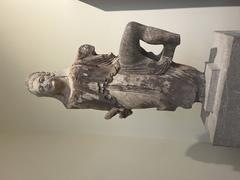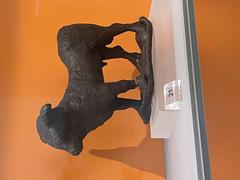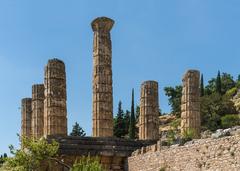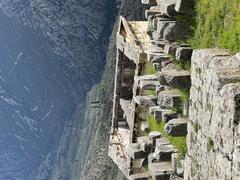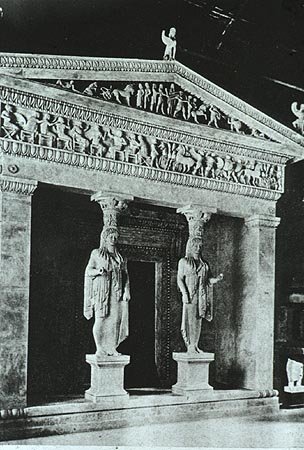
Siphnian Treasury Delphi: Visiting Hours, Tickets, and Historical Significance
Date: 15/06/2025
Introduction
The Siphnian Treasury at Delphi is a striking monument that encapsulates the religious, artistic, and political dynamism of ancient Greece. Situated along Delphi’s Sacred Way, it stands as a symbol of the island of Siphnos’ prosperity and devotion to the god Apollo. Built around 525 BCE, the treasury is renowned for its pioneering use of marble, its innovative Ionic architectural features, and its elaborate sculptural decoration depicting pivotal mythological narratives. This detailed guide provides visitors with everything they need to know about the Siphnian Treasury, from historical context and architectural highlights to practical tips on visiting hours, tickets, accessibility, and nearby attractions (Visiting the Siphnian Treasury at Delphi; Siphnian Treasury at Delphi).
Table of Contents
- Historical Context and Construction
- Architectural and Artistic Features
- Visiting Information: Hours, Tickets, and Accessibility
- On-Site Experience and Nearby Attractions
- Practical Tips for Visiting
- Frequently Asked Questions (FAQ)
- Conclusion and Further Resources
- References and Further Reading
Historical Context and Construction
Siphnos: Wealth and Motivation
In the 6th century BCE, Siphnos, an island in the Cyclades, was celebrated for its rich gold and silver mines. The Siphnians, flush with wealth, decided to dedicate a treasury at Delphi as a religious offering to Apollo, reflecting both their piety and their desire for prestige among Greek city-states. According to Herodotus, they contributed a tithe of their mining profits for this purpose (Wikipedia; Smarthistory).
Treasuries in Panhellenic Sanctuaries
Treasuries at sanctuaries like Delphi were not merely storage buildings; they were acts of civic competition, displaying the contributors’ prosperity and devotion. The Siphnian Treasury, strategically located along Delphi’s Sacred Way, was among the most lavish, designed to impress visitors and assert the status of Siphnos within the panhellenic community (Greek Travel Tellers).
Architectural and Artistic Features
Pioneering Use of Marble and Ionic Order
The Siphnian Treasury is celebrated as the first religious monument on mainland Greece constructed entirely from fine Parian marble, a material prized for its luminosity and durability. The building adopts the Ionic order, notable for its slender columns and elaborate volutes, and features two caryatids—sculpted female figures serving as architectural supports—at its porch, predating the more famous Erechtheion caryatids by nearly a century (Ancient Greece).
Sculptural Mastery: Friezes and Pediments
The treasury’s continuous high-relief frieze, measuring over 60 meters, is a masterpiece of Archaic Greek art. It depicts mythological scenes such as the Gigantomachy (battle between gods and giants), the Trojan War, and the Judgment of Paris, each chosen for their resonance with panhellenic identity and shared mythic traditions. The east pediment shows the dispute between Apollo and Heracles over the Delphic tripod, with Zeus mediating (Greece Is).
Artistic Techniques
The sculptors employed advanced high-relief techniques, lending depth and dynamism to the figures. Traces of polychromy (color) indicate the sculptures were originally painted in vivid hues, enhancing their visual impact. The narrative complexity and technical innovation of the sculpture influenced later classical art and architecture (DaydreamTourist.com).
Visiting Information: Hours, Tickets, and Accessibility
Location and Getting There
The Siphnian Treasury stands within the Archaeological Site of Delphi, on the southern slopes of Mount Parnassus, about 180 km northwest of Athens. It is easily accessible by car (2–2.5 hours from Athens) or by regular intercity bus (approx. 3 hours) (theDelphiGuide.com).
Opening Hours
- Summer (April 1 – October 31): 08:00–20:00 (last admission 19:40)
- Winter (November 1 – March 31): 08:30–15:30 (last admission 15:10)
- Hours may vary due to daylight and special events—confirm on the Official Greek Ministry of Culture site before your visit.
Tickets and Admission
- Standard ticket: €12 (April–October), €6 (November–March)
- Reductions: €6 for non-EU students, free for EU citizens under 25, and children under 5
- Combined Ticket: Includes both the archaeological site and the Delphi Archaeological Museum (entrance-fee.com)
- Booking: Online booking is recommended to avoid queues (thebettervacation.com)
Accessibility
The site is on uneven, hilly terrain with ancient stone paths and steps. Full wheelchair access is not available, but the museum is more accessible and displays the original sculptures from the treasury. Visitors with mobility concerns should plan accordingly.
On-Site Experience and Nearby Attractions
At the Siphnian Treasury
- Only the foundation of the treasury remains on-site, clearly marked along the Sacred Way (pleiades.stoa.org).
- Interpretive panels in Greek and English provide historical context.
- The Delphi Archaeological Museum (included in your ticket) houses the original friezes and caryatids, allowing close-up appreciation of the artistry.
Other Key Sites in Delphi
- Temple of Apollo: The spiritual heart of Delphi, famed for its oracle.
- Delphi Theatre and Stadium: Offering panoramic views and insights into ancient performances.
- Athenian Treasury: Another monument along the Sacred Way, illustrating the competitive display of civic pride.
- Modern Delphi: The nearby town offers restaurants, shops, and hotels for extended stays.
Facilities and Visitor Conduct
- Restrooms are available near the entrance.
- No food vendors on-site—bring water and snacks.
- Photography is allowed for personal use; tripods and drones require special permission.
- Respect site regulations: do not climb on ruins or remove stones.
Practical Tips for Visiting
- Best Seasons: Spring (April–June) and autumn (September–October) offer pleasant weather and fewer crowds. Summer can be hot and crowded; winter is quiet but with reduced hours.
- Recommended Duration: 2–3 hours for the archaeological site, plus 1 hour for the museum.
- Clothing: Wear comfortable walking shoes and bring sun protection.
- Early or Late Visits: Mornings and late afternoons are cooler and less crowded, ideal for photography.
- Guided Tours: Available from Athens and locally, often including expert commentary and museum access.
Frequently Asked Questions (FAQ)
What are the Siphnian Treasury visiting hours?
The site is open daily, with seasonal hours (see above). Always check the official site for current information.
How do I buy tickets?
Purchase at the entrance or online. Combined tickets include the museum (thebettervacation.com).
Is the site wheelchair accessible?
The outdoor site is not fully wheelchair accessible, but the museum is.
Can I take photos?
Yes, for personal use. Special permits are needed for tripods or drones.
Are guided tours available?
Yes, both from Athens and on-site.
Conclusion and Further Resources
The Siphnian Treasury is a highlight of the Delphi Archaeological Site, offering a unique window into the religious fervor, artistic innovation, and civic pride of ancient Greece. By planning ahead—considering visiting hours, ticketing, and practical tips—you can fully appreciate the monument’s historical significance and the broader sanctuary of Delphi. For more guides, updates, and virtual experiences, download the Audiala app and follow our social media channels. Begin your exploration of one of Greece’s most iconic archaeological treasures today!
References and Further Reading
- Visiting the Siphnian Treasury at Delphi: History, Tickets, and Travel Tips
- Siphnian Treasury at Delphi: Visiting Hours, Tickets, and Architectural Significance
- Siphnian Treasury at Delphi: Visiting Hours, Tickets, and Historical Significance
- Siphnian Treasury Visiting Hours, Tickets, and Guide to Delphi Historical Sites
- Official Greek Ministry of Culture
- Ancient Greece: Siphnian Treasury
- Smarthistory: Siphnian Treasury
- Greece Is: The Siphnian Treasury at Delphi
- Delphi Archaeological Museum
- Daydream Tourist: Visiting Delphi
- Pleiades: Siphnian Treasury
- Entrance Fee Information for Delphi
- The Better Vacation: Delphi Archaeological Site
